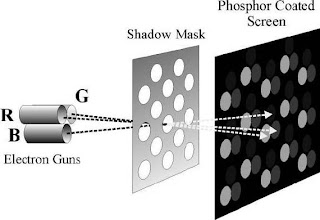CRT Basics
The most widely used technique to represent a picture and the most useful one in today’s era is still the CRT. This is the same technique used in home television sets.
There are mainly two types of CRT’s namely, magnetic deflection and the other is electrostatic deflection. A beam is projected first, from the highly excited electron gun and further the beam is deflected from the focusing system along with magnetic deflection coils and this coil adjusts a particular point on the phosphorous screen. Since, the phosphorous has a property of illumination and thus the striking of an electron causes the illumination. This illumination lasts exponentially and thus it needs to be refreshed. Hence, in case of raster scan system sixty frames per second needs to be refreshed for continuous view.
The most important component of CRT is an electron gun which consists of a heating element, a control grid, a focusing anode and an accelerating anode. The heating element ignites and excites an electron, projects towards focusing anode which focuses the electron towards a particular position on the phosphorous screen and to increase the speed we use accelerating anode. Since, (+ve and –ve) charge attract each other and hence the electron gets speed up towards the screen.
Beam – Penetration Method
This method is again used for displaying color pictures in random scan monitor. In this we use two layers of phosphor namely, red and green which are coated onto the internal part of CRT screen and the final color generated depends upon the penetration level of the beam. A beam of slow velocity of electrons is capable of only exciting the outer red layer and the beam of fast moving electrons get through the red layer and excites the green inner layer. Further, orange and yellow colors are emitted on the intermediate velocity of the electron beam. All this acceleration is controlled by beam-accelerating voltage. The only drawback of this method is that it is only capable of producing four colors and hence picture quality is not good.
Shadow Mask Method
The method used in color T.V. sets. This is capable of producing much more colors. This has (RGB) i.e. Red, Green and Blue phosphor color dots at each pixel position. It consists of three electron guns corresponding to each pixel position. The phosphor dots are just arranged in a triangular position. The arrangement of it is done such that corresponding color is ignited by just the same type of electron gun passing through the shadow mask. Now again, different colors are prepared on the basis of intensity of projected electrons. In this case we can have eight different kinds of colors.
The Direct View Storage Tube (DVST)
The technology uses high rated phosphor which can hold the illumination for longer period of time as compared to simple phosphor. Its refresh rate is 30-50 frames/sec. and it can be used to draw vector graphic system because for dynamic picture this is not a good option since, it does not have a good picture clear/erase technology. It has flickering effect due to discontinuity of picture.
Raster Scan System
This system deals with the entire system of the formation of a raster scan image. This system uses the core method of raster scan technology. Here, a screen is divided in the coordinates as (640,480). In most of the system top-left coordinate is initialized as (0, 0). The whole screen will be plotted in the even and odd way along y-axis, i.e. firstly 1, 3 or 2, 4 and so on. This method is used so that all the pixels are illuminated at much faster rate. In this, scanning is done in two ways. So, the system that keeps track of such a technology is termed as raster scan system.
In this system, CPU is connected to the system bus which acts as a common terminal to carry data and at one end it’s connected to system memory and other are video controllers which are also connected to each other. In this system memory is portioned as frame buffer to record the frame each time a new frame is generated. The video controller controls all the components relating to frame rate etc. This all is further connected to monitor for final display work.
Graphic Driver
Video controller or the graphic card is one and the same thing. This is just the upgraded version of free buffer which we earlier used as a portioned part.This is done so to increase the system RAM so that we can increase the speed of a computer system, rest the work is same.
Glossary:
Persistence- The time taken by the illuminated light from the phosphor coated stream to decay one-tenth of its original intensity.
Resolution- Number of points of pixels which can be drawn without overlapping each other on the screen.
Aspect Ratio- It is the ratio of vertical pixels to the horizontal pixels which are required to display equal length line in both directions.






0 comments:
Post a Comment